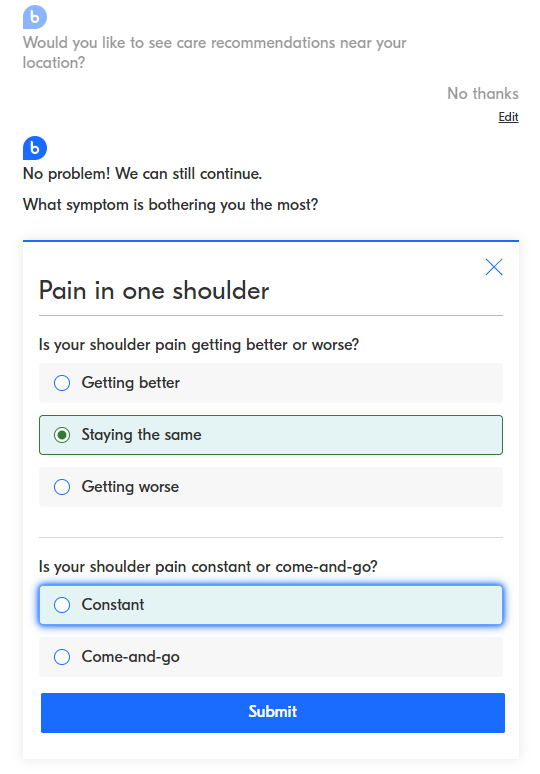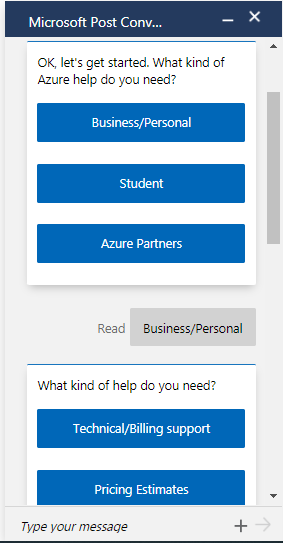10 Reasons To Start Using Chatbot For Your Startup
Today, chatbots are no longer just fancy gimmicks used to show how tech-savvy your company is. They are steadily advancing in the realm of must-haves, being highly appreciated by both businesses and their customers. The global chatbot market shows similar trends – it is expected to grow with each year and is forecast to reach $4.9 billion by 2032.
This trend is accompanied by the increasing adoption of chatbots by customers – 74% of them would prefer a chatbot to a human agent when searching for answers to simple questions – and the businesses’ response to this demand. For startups, the most obvious takeaway from this pattern is that implementing a chatbot may be a good idea.
However, not all chatbots are created equal and not all of them may be a perfect choice for a startup. This post is going to help you choose the type of chatbot for your business and make the most out of it.
Types of chatbots for businesses
In a nutshell, a chatbot is any software that can simulate conversation. Today, chatbot technology allows building not just simple rule-based chatbots but also sophisticated AI-powered tools that can hold human-like conversations. Popular voice assistants, such as Siri or Alexa, are, in fact, chatbots, too. And even ChatGPT that everyone is so excited about is a chatbot, albeit an especially intelligent one.
What we are the most interested in, though, are simple text chatbots that are the best solution for customer-facing businesses. Yes, those little widgets in the bottom-right corner of the website that invite you to start a dialogue. They are the least costly, the easiest to implement, and the most effective for startups.
Simple chatbots fall into the following two main types:
- Rule-based chatbots. These chatbots work along a pre-defined script consisting of a set of “rules”. With these chatbots, users are offered a number of options to choose from, and the conversation progresses according to the user’s choices. Such bots do not support free text entry and only return pre-programmed responses. As an example, you can look up the Buoy Health chatbot that helps you check your symptoms by suggesting to choose one of the options:

- Keyword-recognition chatbots. They are based on Natural Language Processing (NPL) and thus can handle more complex conversations. Users can enter text, in which the bot finds keywords and supplies the corresponding response.
There may be hybrid options, too, where the chatbot supports both a number of pre-defined scripts and a keyword-based free text conversation. For example, the bot on the Microsoft Azure website supports both rule-based flows and free-text messages:

Most common chatbot use cases
If we say that any business that offers products or services to customers would benefit from implementing a chatbot, that would be true. Indeed, the majority of chatbot use cases lie in the area of customer communication and service.
Customer support and onboarding
Chatbots can be the guide that leads customers along their journey. They provide links to useful content, give answers to the most popular questions, and help to troubleshoot common issues. This way, customers can get started easier and achieve success sooner. Using a chatbot as one of the customer support channels is a common practice that is highly appreciated by users.
Assistance with basic operations
Chatbots often serve as virtual assistants helping customers with routine operations. In a bank, customers can use a chatbot to check their account balance, make payments, or open accounts; in a travel agency – confirm, change, or cancel a reservation, inquire about availability or price; in a logistics company – track a delivery, update their address or file a claim.
Help during online shopping
In eCommerce companies, chatbots can become virtual assistants answering customers’ questions about colors, sizes, collections, and prices. They can recommend products, help to find matching items, explain delivery and return policies, and offer subscriptions to loyalty programs. Solutions such as GPT's chat can provide product and company information, recommendations and help clients in making a purchasing decision.
Schedule management
Healthcare and education organizations or HR agencies enjoy chatbots to manage student, patient, and candidate visits. By integrating a chatbot with an online calendar or scheduling app, they can schedule meetings and appointments, amend or cancel them, send reminders, and share agendas.
Feedback collection
A chatbot can also be a place where customers rate their experience of doing business with the company. It can be either a simple star rating or a more complex form allowing users to express their opinions.
Increasing employee efficiency
GPT chat, as well as similar language models, are used in many fields, such as customer service, education, and business. Their use can affect employee efficiency by answering questions related to internal procedures and company policies, managing schedules, editing shared documents, summarizing, and creating emails and presentations. They are also gaining popularity due to their ability to support the creation of content for newsletters, for the company's blog or to help write publications for the brand's social profiles.
Why use a chatbot in your startup
Implementing a chatbot brings multiple benefits, both for businesses and their customers.
Real-time communication with multiple customers
A chatbot is a piece of code, therefore, it can handle as many dialogues as necessary, all of them in real time. As a result, a chatbot can serve more customers than a human agent and reduce the customers’ waiting time, which contributes to overall customer satisfaction improvement.
Besides, chatbots can handle as much as 68% of chats independently. Such chats usually contain basic questions, such as “What are your delivery terms?”, “How can I change my password?”, “I need to check my account balance”, and in most cases, result either in redirecting the user to a knowledge base article or in offering to fill in a form.
24/7 availability
Unlike human agents, chatbots can work 24 hours a day, 7 days a week. This is useful when you want to widen your geography and reach users in other areas and time zones. By implementing a chatbot, you can continue providing service even outside your working hours.
If your chatbot has an option of connecting users to a live agent (which is always a good idea), it can serve as an out-of-office assistant when your team is offline. Just add a message offering the customers to leave their email addresses for the agent to get back to them later. Besides, it may be a good email-harvesting opportunity, too.
Reduced human error rate
Chatbots do not get tired or hungry, they are never distracted even when handling a dozen conversations on different subjects at once. They do not “read” your message with their eyes but rather consume it as a piece of data.
This is where chatbots may be sometimes more efficient than people, as they are less prone to human errors. A chatbot will never mistype a figure, mix June with July, or click a wrong link. In this context, chatbots can be considered rather reliable. Of course, there may be cases when they do not understand what the customer wants, and this is when a “Connect to an agent” option may be useful.
Multi-language support
If your business is targeting different markets, you may expect your audience to speak different languages. A chatbot with an integrated translation feature will be able to detect the language of the customer and answer in the same language.
A multilingual chatbot can be a considerable competitive advantage for a business. When customers can communicate with your service in their native language, they get a much better experience, which can become a decisive factor in choosing to do business with you.
Lower customer service cost
By taking over a significant amount of the service team’s workload, chatbots can contribute to the reduction of the company’s costs. When a chatbot becomes a “member” of the team, other agents might have more time to handle complex cases or engage in self-development.
With a chatbot, you may see that you do not need to expand the team or assign people to night shifts. Such savings can be important for a startup when finances are still rather tight. On a global scale, chatbots can generate as much as $8 billion in savings per year.
Personalized approach to customers
Chatbots that support free-text conversations can use the information customers provide to build a more personalized dialogue. They often ask for the user’s name and address them by it in the conversation.
In addition, a chatbot might ask for the user’s location to suggest offline stores in the vicinity. Or, for example, when the bot is handling an order, it can finish by repeating its content and reconfirming the delivery address.
Another good idea may be studying your core target audience and adapting the chatbot’s vocabulary accordingly. Difference demographic groups may like it when the chatbot speaks to them in their language and, as a result, engage better.
High customer satisfaction
In the context of customer experience and satisfaction, the role of chatbots is significant. They reduce waiting time, provide accurate answers, and can be reached at any time.
Besides, chatbots are a self-service resource, which people end to find very convenient and satisfying. 67% of consumers prefer to resolve their issues on their own rather than talk to a support agent. This is one of the reasons customers like chatbots and often rate their conversation experiences as positive.
Conversation marketing opportunities
Conversational marketing is a technique of building relationships between a business and a customer through dialogue. Chatbots are a perfect channel for such marketing activities. With the high level of personalization that chatbots can achieve, they can deliver precisely targeted messages to the audience.
Chatbots can also serve as a lead-generating and qualifying tool. Through special pre-qualifying scripts, they determine the customers’ needs and also collect their contact details in the process.
If you use a social media chatbot, such as Facebook Messenger, you can make it a part of your social media marketing strategy and thus add one more channel for reaching the customers where they are.
Analytical features
By collecting and analyzing the chatbot performance data, you can check how it is doing and how satisfied customers are with it. Each conversation brings information about the number of messages it took to resolve the issue, whether the chat needed to be transferred to a human agent, if the chatbot understood all the customer’s inquiries, and so on.
This data allows you, on the one hand, to improve the chatbot functionality, for example, by adding new “branches” to its script or keywords for the bot to recognize. On the other hand, you can get a broader picture of the customers’ needs and requirements and make the corresponding improvements. For example, if you see that a certain question occurs very often in conversations, it may be wise to add it to the FAQs or knowledge base.
Easiness of implementation
For startups, the good news is that chatbots require no coding skills to be integrated into your infrastructure. If you implement a customer service platform, most probably, it will include a chatbot. It usually comes with a script builder and customization options.
Other tools allow you to build a chatbot and integrate it into your website or Facebook page. Such tools are very intuitive and easy to use. Often, they support a drag-and-drop editor where you can immediately see how your chatbot is going to look.
Wrapping up
For a startup, a chatbot is definitely an additional investment. However, it is an investment that is going to pay back in spades through cost reduction, the service team's happiness, and higher customer satisfaction.







